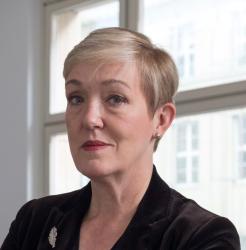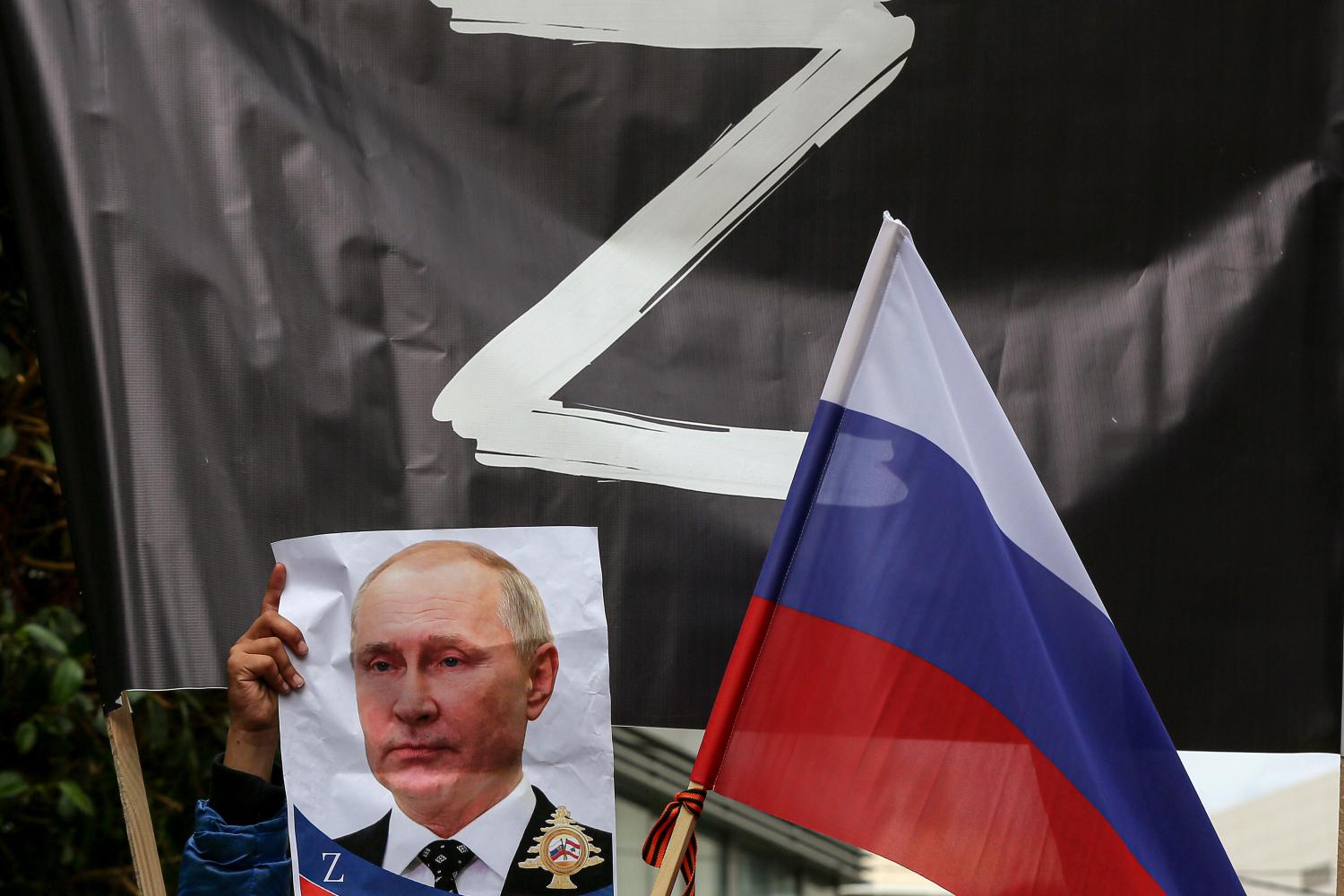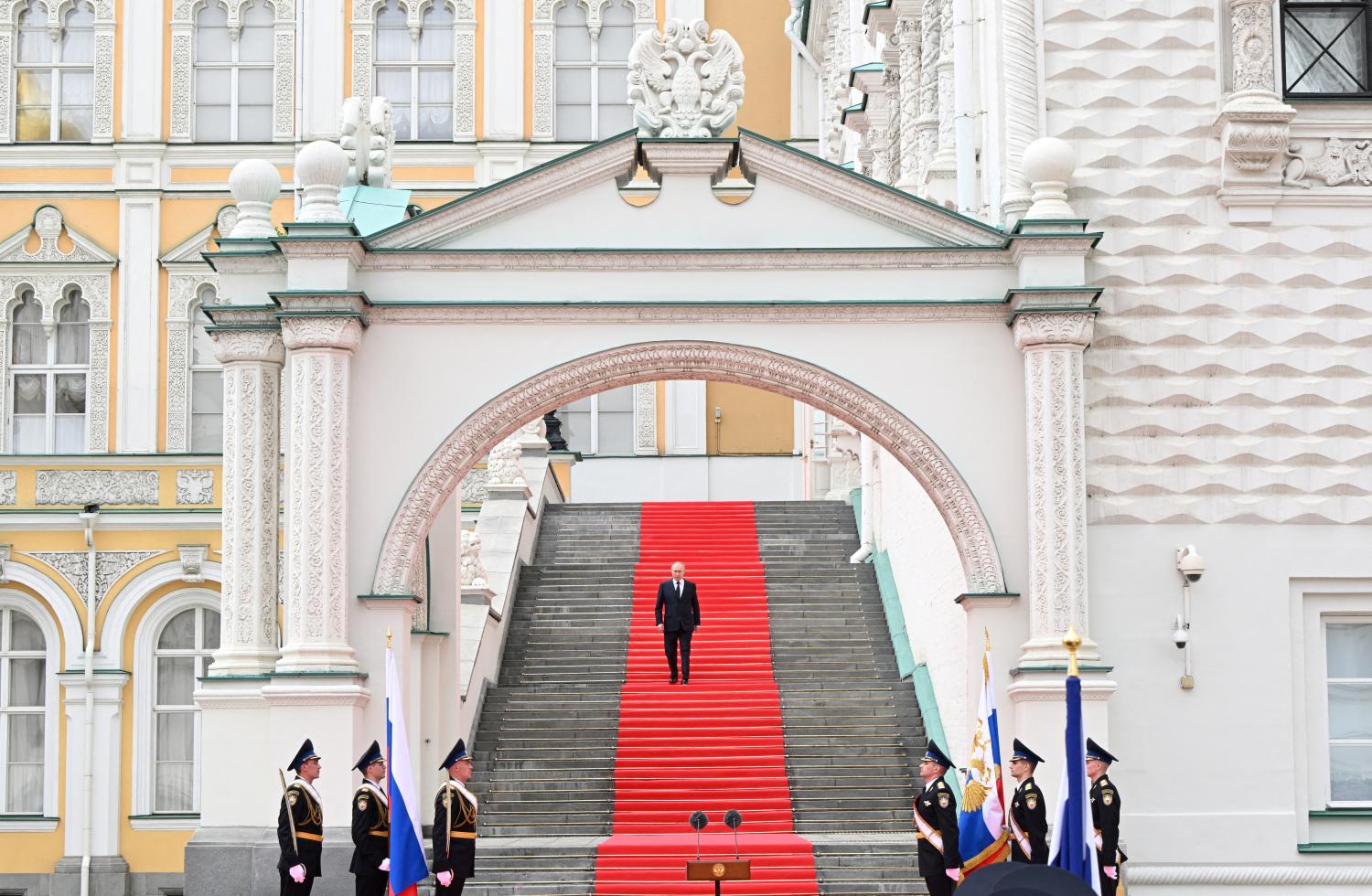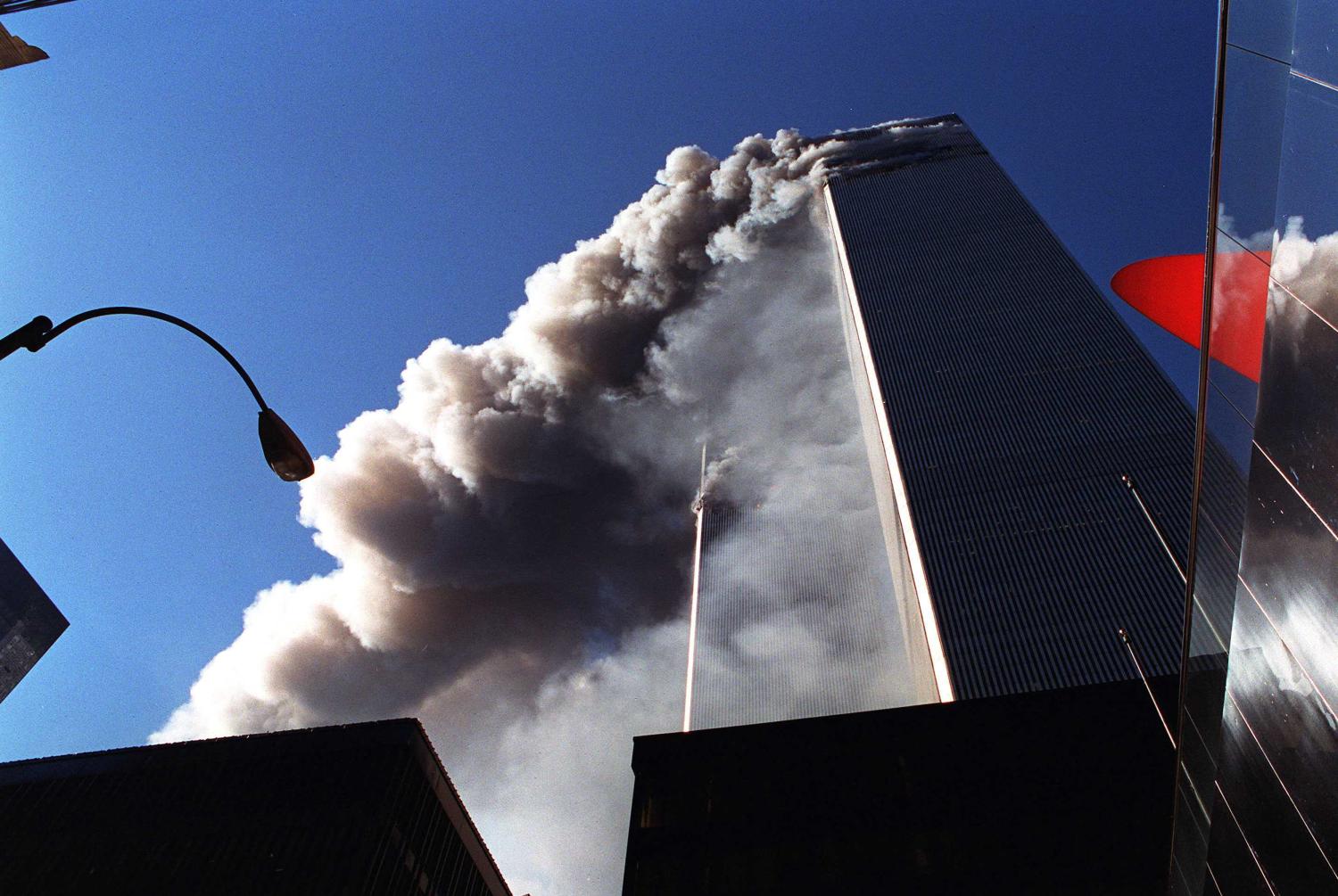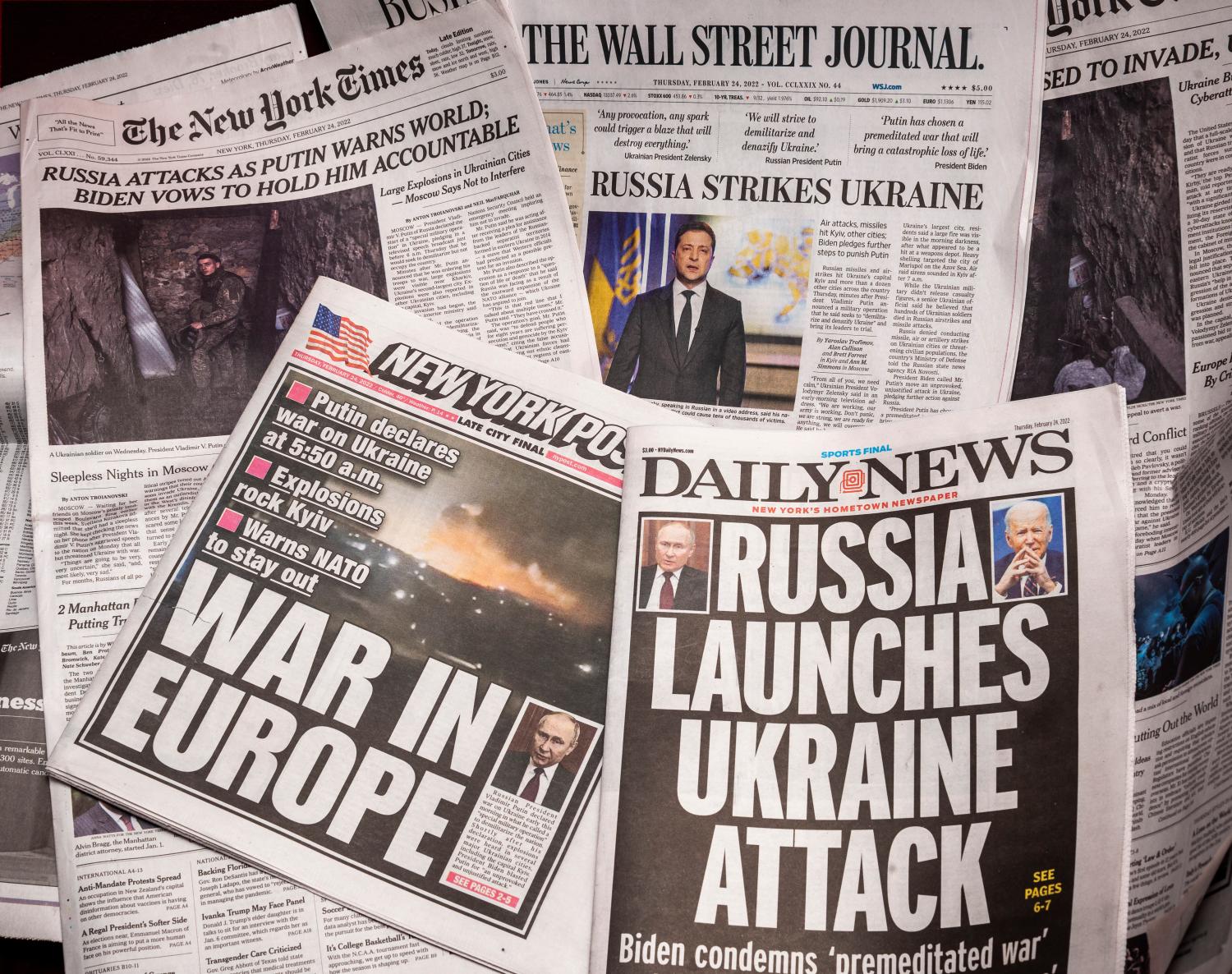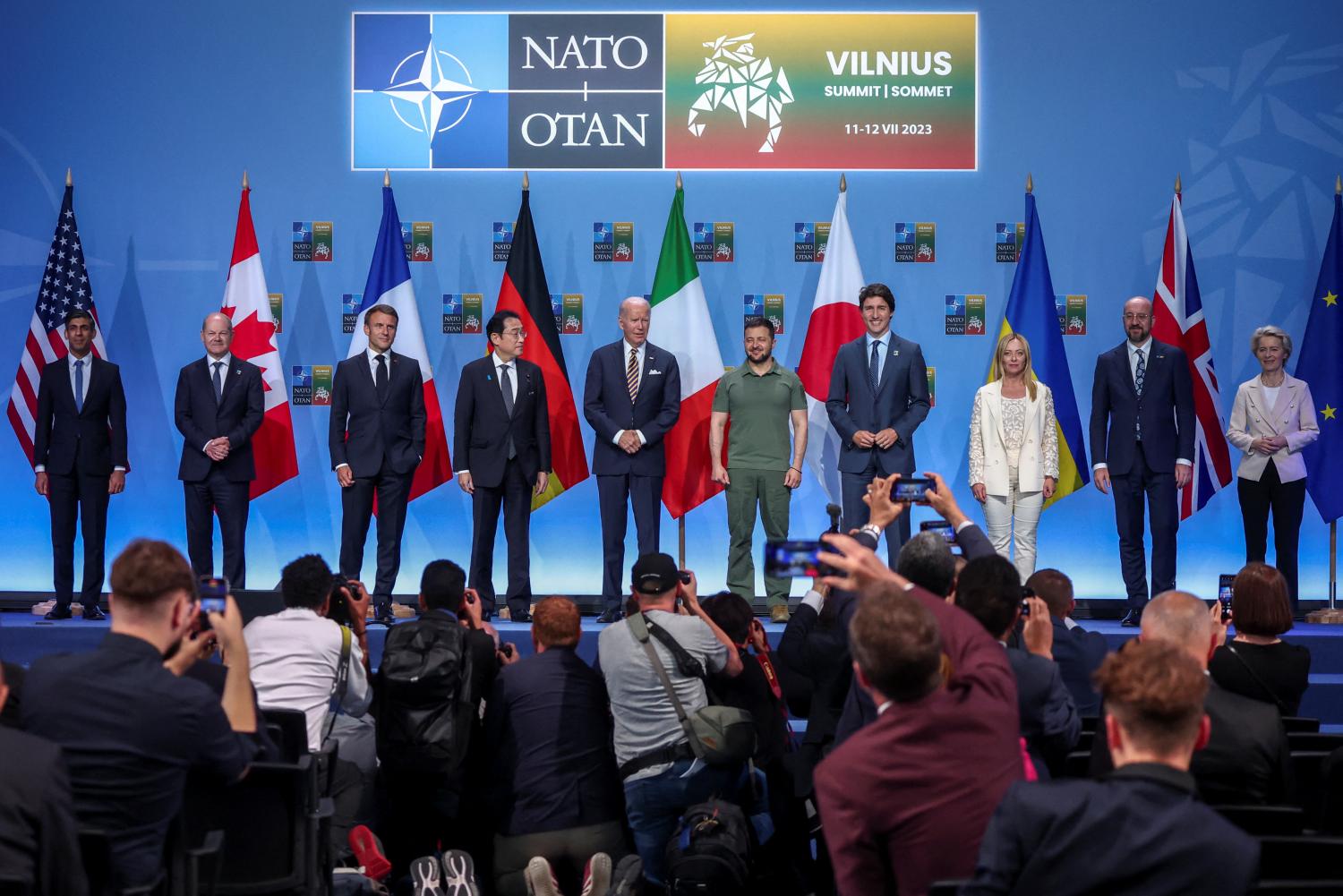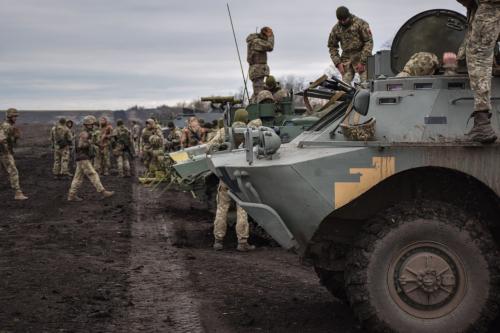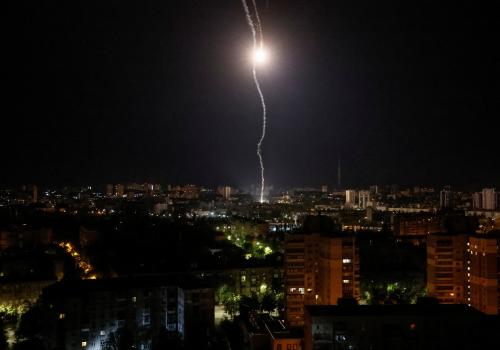This is a translated, expanded, and updated version of an essay that appeared in the German magazine Kursbuch in June 2023. This piece is part of a series of policy analyses entitled “The Talbott Papers on Implications of Russia’s Invasion of Ukraine,” named in honor of American statesman and former Brookings Institution President Strobe Talbott. Brookings is grateful to Trustee Phil Knight for his generous support of the Brookings Foreign Policy program.
Eighteen months after Russian President Vladimir Putin’s unprovoked full-scale invasion of his country’s sovereign neighbor on February 24, 2022, the question of how this war ends appears as open as ever. Ukraine has put up a heroic resistance to the invaders. The West, under U.S. leadership, and with huge financial and material outlays on both sides of the Atlantic, has helped. Kyiv’s counteroffensive is producing modest successes. But it is equally clear that it is taking a terrible toll — on Ukraine’s armed forces, on its citizens, and on its supporters worldwide. Russia, too, is taking heavy losses, has failed to reach key goals, and is arguably running out of options; the brief mutiny of Wagner Group leader Yevgeny Prigozhin has revealed startling vulnerabilities in the top echelons of the Kremlin, including of Putin himself.1 Still, Moscow continues its barbaric, indiscriminate attacks against Ukraine’s troops, its people, its cultural heritage sites, and the infrastructure of its economy.
Is it time — as critics continue to argue — to seek a compromise solution instead of further arms deliveries in order to prevent further bloodshed or a disintegration of the Western coalition?2 Might it even be imperative for Ukraine to renounce regaining its entire territory in order to avoid defeat, the expansion of the war to neighboring states, a nuclear escalation by the Kremlin, or starvation in the world’s poorest countries? Certainly, Vladimir Putin appears to be calculating that time is on his side. “Far from seeking an off-ramp,” Alexander Gabuev writes, “Vladimir Putin is preparing for an even bigger war.”3
Such a compromise peace would demand a near-superhuman degree of pragmatism and self-denial from the Ukrainians, who are victims of a war of aggression, war crimes, and crimes against humanity, and who live under almost continuous Russian bombardment. The critics’ fears are nonetheless worthy of careful consideration because they are realistic. They are heightened by the visible fact of Western governments struggling with numerous other disruptive challenges, as well as the prospect of a string of elections in key states, from Poland in October 2023 to the United States in November 2024; all of which appear to be empowering the extreme right, or at least driving up the price of voter consent. Notably, opposition against U.S. support for Ukraine is rising in the ranks of Republican presidential candidates and among their voters as the election campaign takes off.4 Responsible policymakers must acknowledge these constraints and weigh the costs and risks of all options.
Putin’s Russia: Take it literally and seriously
And yet the calls for negotiation elide a central question: What if Putin’s system and the Russian president himself are unwilling — even unable — to reach such a compromise? The distinguished German historian of Eastern Europe Karl Schlögel has described Putinism succinctly: “a violence-based order following on the demise of a continental empire and a system of state socialism” rooted in a “Soviet-Stalinist DNA … It includes the targeted killing of political opponents, commonplace violence in prisons and camps, impunity for crimes, arbitrariness, conspiracy myths, the notion of ‘enemies of the people.’”5
In his now notorious historical essay “On the Historical Unity of Russians and Ukrainians” from the summer of 2021, Putin flatly — and not for the first time — denied Ukraine’s right to exist as an independent country; it was, he wrote, a component (together with Belarus) of a “single large nation, a triune nation.”6 The Kremlin has repeatedly made it clear that only Ukraine’s complete surrender, including the relinquishment of its sovereignty, is acceptable as the basis for a peace agreement.
This maximalist intransigence is by no means limited to Ukraine. On December 17, 2021, the Kremlin sent two similar “draft treaties” to the White House and to NATO headquarters in Brussels which articulated the Kremlin’s goals for Europe with remarkable clarity.7 The demands in the proposals — which were immediately dismissed by their recipients — included not just a veto on Ukrainian membership in the alliance but a revision of the Euro-Atlantic security acquis of the post-Cold War period on enlargement, basing, deployments, exercises, and cooperation with partners. They would have severely limited U.S. freedom of movement in Europe (with no concomitant limitations on Russia), reversed 25 years of Central and Eastern European integration into NATO and the European Union, ended the right of non-members to choose their own alliances, and re-established a Russian sphere of influence on the continent.8 The coup de grâce was the final stipulation (Art. 7) of the draft U.S.-Russia treaty, that all nuclear weapons should be returned to their national territories: it would have meant the end of the U.S. nuclear umbrella over Europe and thus quite possibly of the alliance itself.
As my Brookings colleagues Fiona Hill and Angela Stent have warned: “This war is about more than Ukraine. … Ukrainians and their supporters understand that in the event of a Russian victory, Putin’s expansionism would not end at the Ukrainian border. The Baltic states, Finland, Poland, and many other states that were once part of the Russian empire would be at risk of attack or overthrow from within.”9
Konrad Schuller, the Eastern Europe correspondent of the German daily Frankfurter Allgemeine Zeitung, adds that the proponents of negotiations misjudge the categorical nature of this hostility: “In the case of total enmity, compromise never serves anything but a tactical pause.” This approach, he writes, has “deep roots in the Soviet Union,” and has been demonstrated time and again by Putin, as in the systematic violation of the Minsk agreements from the outset.10
It appears Putin must be taken — like Donald Trump — literally and seriously.
It appears Putin must be taken — like Donald Trump — literally and seriously. That, in turn, requires confronting something else: the return of the category of the enemy to security policy.
1989: The end of enmity
The key theorist of this concept in the 20th century was Carl Schmitt, a fierce critic of liberal modernity, parliamentary democracy, and political pluralism; also an ardent antisemite. Despite his refusal to distance himself from his role as “crown jurist of the Third Reich,” his thought has unleashed what Jan-Werner Müller described as a “great and lasting intellectual fallout” for debates about political geostrategy to this day — not only in the West, but also in Russia and China.11 For Schmitt, the concept of the enemy is the essence of the political: “The political enemy is … the other, the stranger; and it is sufficient for his nature that he is, in a specially intense way, existentially something different and alien, so that in the extreme case conflicts with him are possible.”12 Enmity is not meant here in a metaphorical sense: “The friend, enemy, and combat concepts receive their real meaning precisely because they refer to the real possibility of physical killing. War follows from enmity. War is the existential negation of the enemy.”13 Schmitt distinguishes here between “real” and “absolute” enemies: the former are capable of a territorial reconciliation of interests; the latter are incapable of this because of the ideological nature of their antagonism.14
During the Cold War, much of the world was divided into camps of friend and foe, some of which were separated by genuine fortified borders such as the Berlin Wall and the Iron Curtain. The West’s adversary was the Soviet Union, a rival superpower with a totalitarian ideology and a “settled and implacable hostility,” together with the Warsaw Pact.15 In the words of John Lewis Gaddis, Western leaders envisaged a postwar European security order “that assumed the possibility of compatible interests, even among incompatible systems” — whereas Josef Stalin’s goal was “the eventual Soviet domination of Europe,” and it “assumed no such thing.”16 The states of the West, on the other hand, as former French Defense Minister Jean-Yves Le Drian noted in 2016, no longer defined their national identity after 1945 in opposition to a “demonized Other.”17
It seemed that the phenomenon of the enemy in international relations had ended up on the garbage heap of history.
After the fall of the Berlin Wall, the United States was left as the only superpower, with no rival far and wide. Its hegemonic status was also reflected in political theory: the so-called theory of convergence, according to which the rest of the world would gradually align itself with the Western model of free-market democracy. (Ironically, the notion of convergence originated in a famous essay by the Russian physicist and human rights defender Andrei Sakharov, whose 1968 essay “Thoughts on Progress, Peaceful Coexistence and Intellectual Freedom” posited that the political systems of the West and the Soviet bloc would converge as their relations thawed.18) Thomas Wright has pointed out that “the notion of convergence pervaded the three post-Cold War U.S. administrations. It was an explicit goal of their strategy and defined the parameters of it.”19
The convergence thesis found its classic expression in a 1990 address to Congress by then-President George H.W. Bush:
“Out of these troubled times … a new world order … can emerge: a new era — freer from the threat of terror, stronger in the pursuit of justice, and more secure in the quest for peace. An era in which the nations of the world, East and West, North and South, can prosper and live in harmony. A hundred generations have searched for this elusive path to peace, while a thousand wars raged across the span of human endeavor. Today that new world is struggling to be born, a world quite different from the one we’ve known. A world where the rule of law supplants the rule of the jungle. A world in which nations recognize the shared responsibility for freedom and justice. A world where the strong respect the rights of the weak.”20
History, as we know, has taken a somewhat different course since then. Nonetheless, there was remarkable progress in the decade that followed, which initially seemed to confirm the hope for convergence. The bipolar order of the Cold War reconstituted itself as an “aspiring global commonwealth that enlarged NATO and transformed the United Nations, the [International Monetary Fund] and the World Bank, the World Trade Organization, and the EU.”21 Not only that, the democratic transformation of almost the entire Warsaw Pact found imitators around the world; civil society movements overthrew authoritarian regimes in Latin America, Africa, and Asia. It seemed that the phenomenon of the enemy in international relations had ended up on the garbage heap of history.
The key proponents of this thesis were the liberal political theorists. Francis Fukuyama’s 1989 essay “The End of History” — arguably the most influential articulation of the theory of liberal entropy — postulated outright that the category of the enemy state, or more precisely, the enemy state with an anti-Western ideology, was doomed to become an anachronism. “The passing of Marxism-Leninism first from China and then from the Soviet Union will mean its death as a living ideology of world historical significance … And the death of this ideology means … the diminution of the likelihood of large-scale conflict between states.” Fukuyama hastened to add that terrorism and wars of national liberation would continue, but “large-scale conflict must involve large states still caught in the grip of history, and they are what appear to be passing from the scene.”22
As late as 2011, the most persistent proponent of the liberal convergence thesis, G. John Ikenberry, inveighed against the “panicked narrative” of the rise of illiberal, authoritarian powers: “China and other emerging great powers do not want to contest the basic rules and principles of the liberal international order; they wish to gain more authority and leadership within it. Indeed, today’s power transition represents not the defeat of the liberal order but its ultimate ascendance.”23
The country that most enthusiastically embraced the narrative of the end of history, the victory of the West through diplomacy and democratic transformation, and the irresistible global spread of a rules-based world order, was reunified Germany. In 2019, the diplomat Thomas Bagger, then head of the planning staff at the German Foreign Office, described Berlin’s interpretation of the Zeitenwende of 1989 with gentle but unmistakable irony:
“Toward the end of a century marked by having been on the wrong side of history twice, Germany finally found itself on the right side. What had looked impossible, even unthinkable, for decades suddenly seemed to be not just real, but indeed inevitable. The rapid transformation of the countries of Central and Eastern Europe into parliamentary democracies and market economies was taken as empirical proof of Fukuyama’s bold headline. … Best of all, while Germany would still have to transform its new regions in the East, the former GDR, the country in a broader sense had already arrived at its historical destination: it was a stable parliamentary democracy, with its own well-tested and respected social market economy. While many other countries around the globe would have to transform, Germany could remain as is, waiting for the others to gradually adhere to its model. It was just a matter of time.”24
Thirty years after reunification, the Germans’ remarkably complacent interpretation of the events of 1989 would become a stubborn cognitive blockage against perceiving and adapting to another, much darker period of climate change in international relations and the global security order.
In the United States, however, the representatives of the realist school of international relations viewed this liberal narrative of a linear arc of history with the same skepticism they harbored for international institutions, international law, and the notion of a liberal world order in general. Realist theorists such as Kenneth Waltz, John Mearsheimer, and Stephen Walt argued that competition was the main driver of the international system. But because realists consider interests to be far more important than ideologies, they are also disinclined to consider a rival state or even an adversary an “enemy” in the Schmittian sense. The competitor’s interests are simply different; this also makes it easier to negotiate with them, to come to a compromise, or even to accept their demand for a sphere of influence.25 This rather relaxed — and quite condescending — view of the phenomenon of interstate competition was doubtless rooted in the fact that until recently the United States had no plausible peer rival. China’s rise has noticeably changed the realists’ tone.
A third school — the constructivists — took exception to the realists’ refusal to acknowledge identity and ideas as key factors in the behavior of states. And it was the constructivist Alexander Wendt who, a decade after the fall of the Berlin Wall, addressed the problem of the enemy head-on. He distinguished between Hobbesian, Lockean, and Kantian orders — based respectively on enmity, rivalry, and friendship.26 Explicitly citing Schmitt, Wendt defined the difference between enemy and rival: “An enemy does not recognize the right of the Self to exist as a free subject at all … A rival, in contrast, is thought to recognize the Self’s right to life and liberty.” He adds: “Violence between enemies has no internal limits. … Violence between rivals, in contrast, is self-limiting, constrained by recognition of each other’s right to exist.”27 Wendt cites post-Cold War conflicts occurring between “Palestinian and Israeli fundamentalists” and in Northern Ireland, Cambodia, Yugoslavia, and Rwanda as examples of hostility. All of these examples, however, are of internal or highly localized conflicts.
At the end of the first Bush presidency (1989-93) and then under his successor Bill Clinton (1993-2001), the United Nations sent peacekeepers to Cambodia and Rwanda, and NATO intervened in the Balkans with combat troops for the first time since its founding. Justifications for sending troops included the need to prevent regional destabilization, to end a humanitarian disaster, or the violation of basic principles of international law such as the prohibition of genocide. Leading Western states had patronage relationships with some of the conflict actors (France-Rwanda; France/U.K.-Serbia; Germany-Croatia), but they never went so far as to consider their clients’ enemies as their own. Meanwhile, relations among the great powers were for the most part stable and constructive. Russian President Boris Yeltsin and U.S. President Clinton clashed over NATO’s air war against Serbia. Otherwise, however, they largely cooperated with each other; Clinton paved the way for China to join the World Trade Organization.
2001: Terrorists, the West’s new enemy
It was the rise of radical Islamist terrorism, al-Qaida’s attacks on America on September 11, 2001, and the subsequent “Global War on Terror” with which the category of the enemy as the enemy of the West returned to trans-Atlantic strategic discourse. The neoconservative strategists of President George W. Bush (2001-2009) were convinced that the terrorists and their state sponsors had to be utterly defeated; they put this conviction into practice by driving the Taliban out of Afghanistan and invading Iraq. Their highly controversial formulas, such as the “axis of evil” or “Islamofascism,” were reminiscent of the “absolute enemy” in Schmitt’s “Theory of the Partisan.”28 What distinguished the neoconservatives from the Schmittians, however, was the fact that they were moral universalists and, in the majority, convinced advocates of a democratic transformation of the Middle East. On this issue, they were in broad agreement with the liberal internationalists.
The Islamist enemy, it was hoped, would also be transformed by the pull of freedom and democracy. As my colleague Robert Kagan wrote in 2008: “The best [option] may be to hasten the process of modernization in the Islamic world. More modernization, more globalization, faster.”29 The great powers of Russia and China would — or so it was assumed — share the task of combating terrorism with the West. For the rest, the great powers would — as the Bush administration’s National Security Strategy put it — “compete in peace.”30 In 2005, Bush’s Deputy Secretary of State Robert Zoellick said that once China became a “responsible stakeholder” in the U.S.-led world order, all differences could be settled in light of shared interests.31
A decade later, Le Drian identified the Islamic State group (IS) as France’s “current enemy.”32 But he simultaneously introduced a distinction that was as precise as it was careful: for France, he explained, IS was an ennemi conjoncturel, an enemy whose status was contingent, depending on the current threat it posed. France, on the other hand, is an ennemi structurel for IS, based on an “apocalyptic, totalitarian, and eliminatory vision of this combat … Our deeds are of little importance from this point of view. We are targeted above all for what we are, and for what we represent.”33 We will have to come back to this distinction.
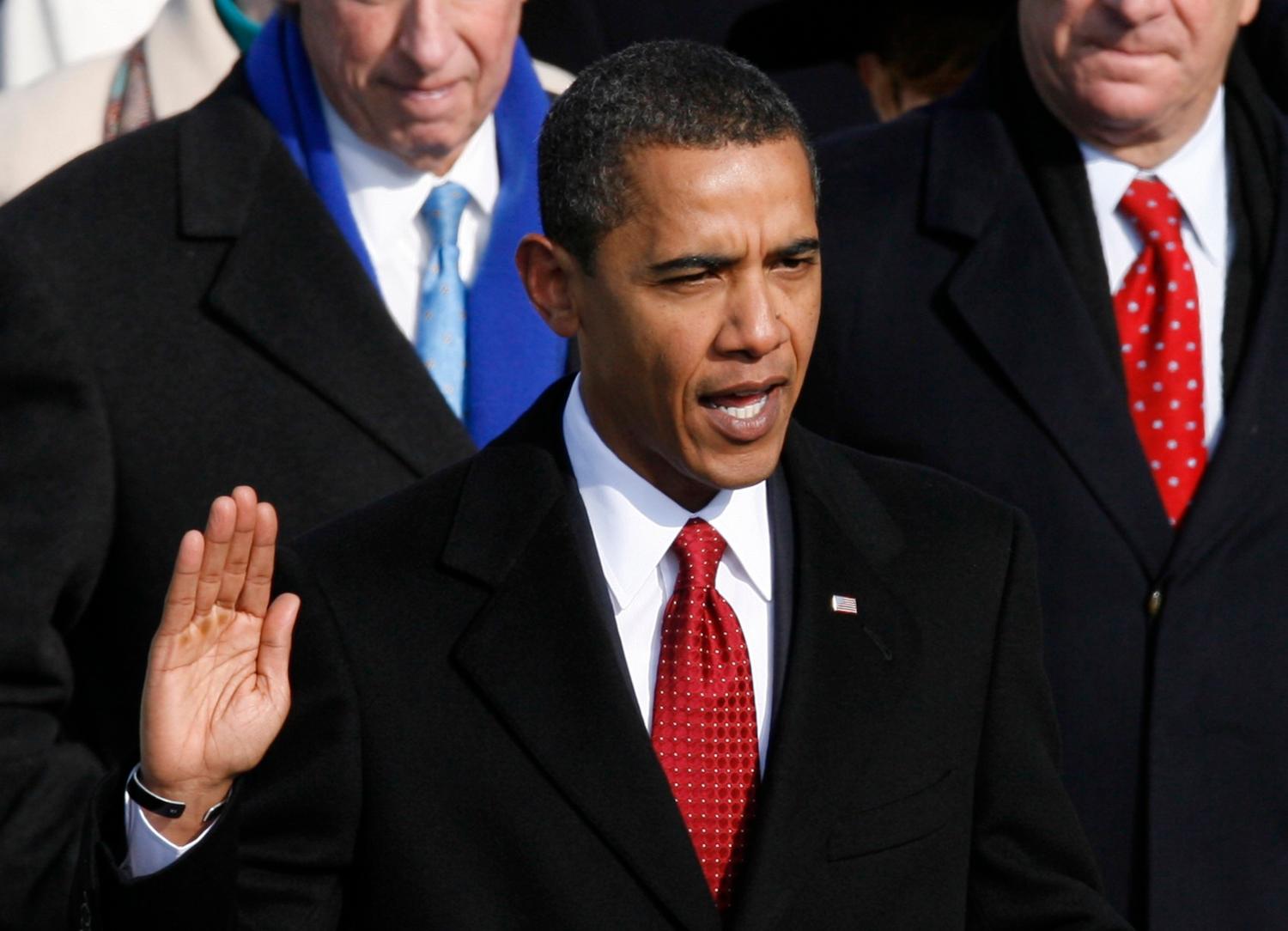
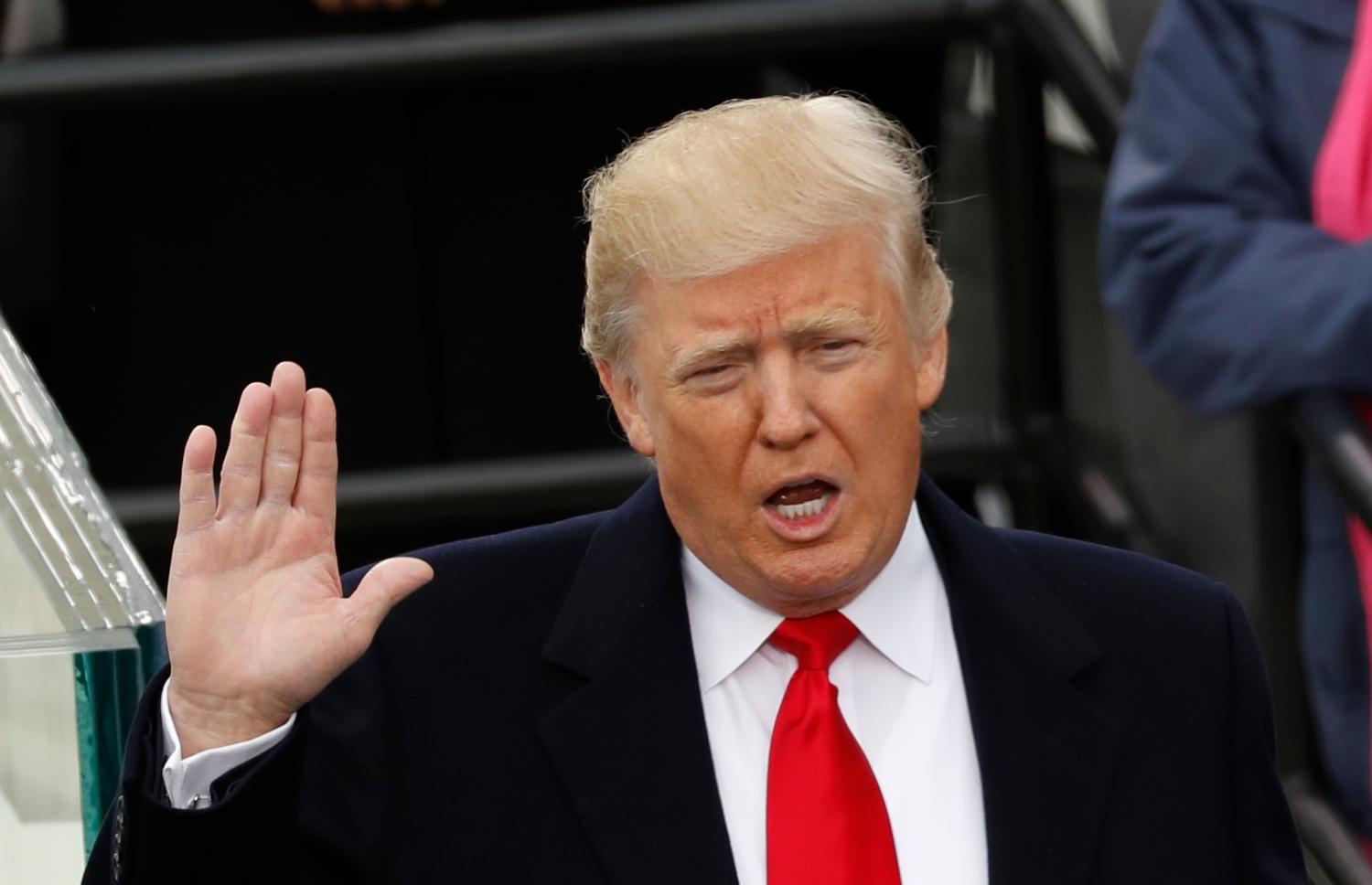
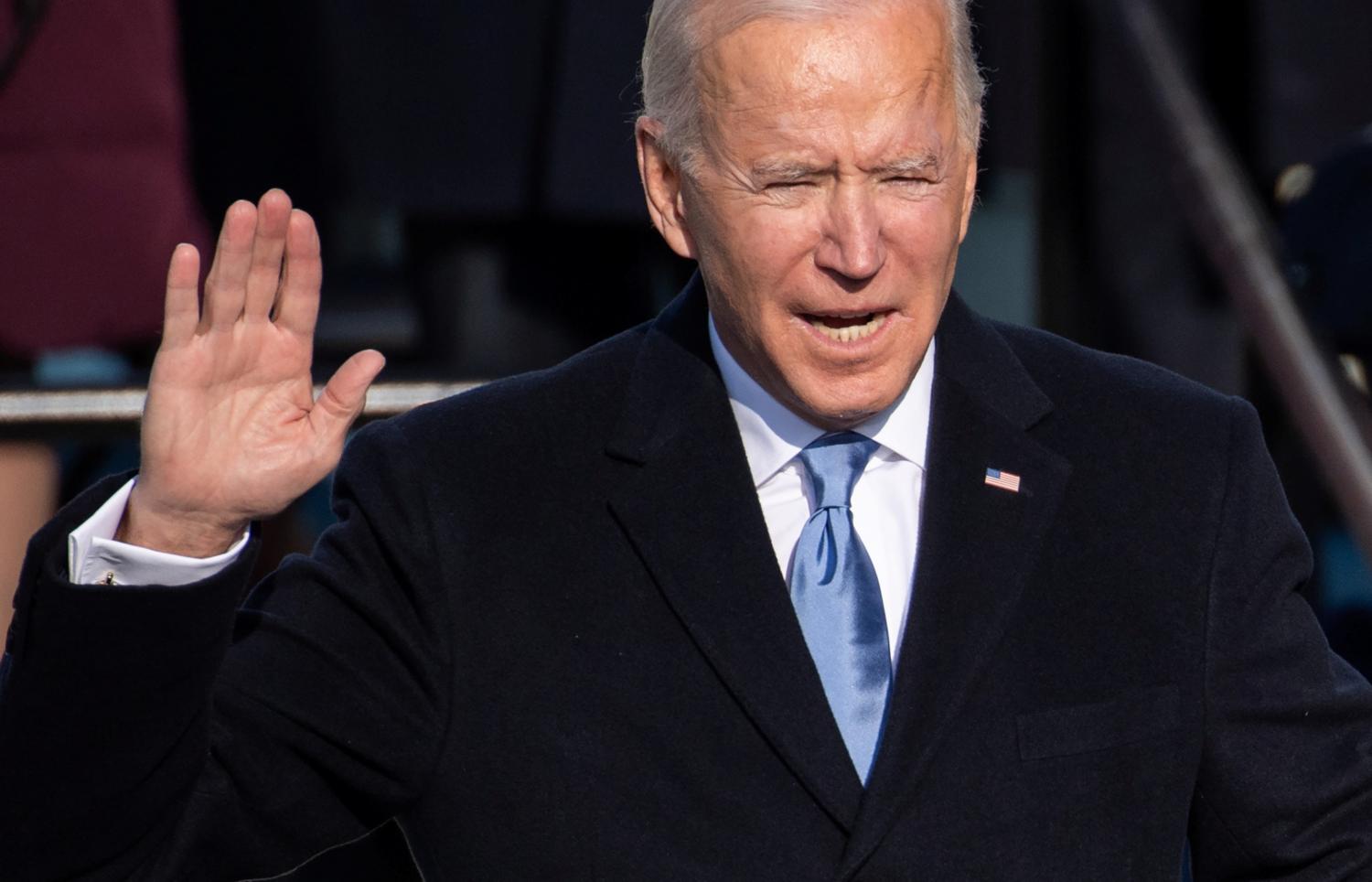
2008-present: The pulverization of peaceful convergence
The presidency of Barack Obama (2009-2016) was the last in the post-Cold War era to spell out its national security strategy within the paradigm of peaceful convergence. Obama, however, viewed the interventionism of his predecessors with skepticism. He understood that competition was rising globally, but he was determined not to let that fact define his administration.34
When Obama took office in 2009, Dmitry Medvedev was his counterpart in the Kremlin. But the power center was Prime Minister Vladimir Putin, who had served once before as prime minister (1999-2000) and as president (2000-2008). Putin had triggered a sharp revisionist turn in Russian foreign policy in 1999 with the bloody Chechen war. In February 2007, he challenged the West in a speech at the Munich Security Conference.35 In August 2008, the Kremlin provoked Georgia into a week-long shooting war as punishment for its aspirations to become a NATO member. Obama nevertheless offered Russia a “reset”; it produced the New START Treaty on strategic arms reduction and greater Russian cooperation on Afghanistan and Iran.
In 2012, Putin again assumed the Russian presidency. Yet even as Russia illegally annexed the Crimean Peninsula in 2014 and sent proxy troops into eastern Ukraine, Obama — supported by German Chancellor Angela Merkel — resisted pressure from Congress and his own administration to send lethal weapons to Kyiv. When Putin intervened in Syria in 2015 in favor of Syrian strongman Bashar al-Assad (triggering Germany’s refugee crisis), the United States also remained reluctant to intervene. Obama believed that the Europeans should take more responsibility for their own security; for him, the most important American security interests lay elsewhere, in Asia.
But China had also become much more power-conscious, both in its own neighborhood and in international institutions. The Obama administration initially took a wait-and-see approach; then it tried to change course with the “pivot to Asia” — with limited success. Derek Chollet, who had served as a senior Pentagon official in the administration, described U.S.-China relations as “increasingly cooperative on select issues, [but] rooted in competition and distrust.”36 Few people, however, would have been less inclined to view a challenging great power like Russia or a rising rival like China as an enemy than the cerebral Obama; indeed, he notoriously dismissed Russia as a “regional power.”
Donald Trump’s term in office did not end the era of friendly convergence — that had already been ‘pulverized’ by the global financial crisis, the failure of the Arab Spring, Russia and China’s increasing challenge to the Western-led liberal world order, and the global rise of populism.
Donald Trump’s term in office (2017-2021) did not end the era of friendly convergence — that had already been “pulverized” by the global financial crisis, the failure of the Arab Spring, Russia and China’s increasing challenge to the Western-led liberal world order, and the global rise of populism.37 But it became the scene of a bizarre power struggle in U.S. security policy between Republican traditionalists and the president. The former sought to articulate a new paradigm of global great power competition with the 2017 National Security Strategy. The document referred to Russia and China as “revisionist powers”; however, it simultaneously emphasized the importance of democracy, values, and allies.38 This restrained intonation of systemic rivalry enjoyed bipartisan consensus. It found an increasing echo in Europe as well — such as in the European Union’s 2019 China Strategy, with its description of the emerging great power as a “partner, competitor, and strategic rival.”39
The commander-in-chief’s political instincts, as it happened, were diametrically opposed to those of his advisers. The president had nothing but contempt for institutions, rules, allies, and especially NATO and the EU; he admired authoritarian leaders like Putin all the more submissively. In all this, Trump was (and is) neither a strategist nor an ideologue, but a transactional “America First” nationalist in a zero-sum world — a theory of American power that an anonymous senior official described as a “no friends, no enemies” policy.40 Trump’s attacks on the rules-based world order were ultimately unsuccessful, as were his attempts to prevent his successor from winning the election. Nor did he manage to stop the U.S. government from providing Ukraine with lethal assistance, increasing sanctions on Russia, and strengthening the American military presence in Europe.41
The lasting damage done by Trump’s tenure, however, was and is the normalization of ethno-nationalism, open contempt for democracy, and violence in the U.S. conservative camp. The enemy of the right-wing of the GOP (as is the case with other radical populists) is none other than liberal modernity itself. The Economist reported from a meeting of the hard-right Conservative Political Action Conference: “the movement’s goal is the utter destruction of the enemy.”42
Joe Biden assumed the presidency of a politically and socially deeply divided country in January 2021, in the midst of a historic pandemic that by today’s count has claimed the lives of nearly seven million people worldwide and has shed an unsparing light on the weaknesses and vulnerabilities of the international order and Western democracies.43 An administration strategy paper from March of that year described Russia as a disruptor (“determined to enhance its global influence and play a disruptive role on the world stage”) and China as a potential peer opponent (“the only competitor potentially capable of combining its economic, diplomatic, military, and technological power to mount a sustained challenge to a stable and open international system”).44
2022: The return of the great power enemy
Only eleven months later, Putin invaded Ukraine; shortly before, Moscow and Beijing had sworn a “friendship” with “no limits.”45 In October 2022, the administration’s National Security Strategy stated succinctly: “The world is now at an inflection point. This decade will be decisive, in setting the terms of our competition with the [People’s Republic of China], managing the acute threat posed by Russia, and in our efforts to deal with shared challenges, particularly climate change, pandemics, and economic turbulence.”46 But in the summer of 2023, fears of a U.S.-China war continue to haunt Western capitals; Russia shows no signs that it might be willing to relent.
The free democracies must now understand that they are dealing with a phenomenon they had believed to be historically obsolete: state rivals who see them as ideological enemies. Specifically, “absolute” enemies as defined by Schmitt, or ennemis structurels, as Le Drian put it. Or — to use a more old-fashioned term — mortal enemies. Whether the leadership in Beijing perceives the nations of the West in this sense can be left open here — but in the case of Putin and his regime, the case is clear. Putin’s frequent characterization of the Kyiv leadership as “Nazis,” the tirades with which Putin rails against a “corrupt” Ukraine and a “decadent” West and threatens to “cleanse” “filth and traitors” in his own population, the threats of nuclear Armageddon — these linguistic tropes are familiar from the history of 20th-century genocides.47
Conceivably, in the case of Putin himself, there is a personal psychopathology at play. Equally possibly, it is — as Fiona Hill argues — simply a cynical terror strategy designed to paralyze the resistance of Ukraine and the West.48 Perhaps Putin is convinced that he can win this way; perhaps he feels compelled to articulate his invasion as a life-or-death struggle because his power and his life depend on not losing? In any case, the facts are that this unhinged language is amplified daily in the most garish colors by members of the Kremlin leadership as well as Russia’s state-controlled media, that it is taken at face value by much of the Russian population, and that it is implemented in brutal and sadistic ways by Putin’s armed forces. In this respect, Putin’s publicly staged hostility has long since developed a political life of its own. “If anything,” writes Tatiana Stanovaya in a compelling analysis of the hardening mood of Russia’s next-generation security elites, “the country is becoming more committed to the fight … No one is seriously considering or discussing a diplomatic end to the war: a notion that looks to many high-profile Russians like a personal threat, given all the war crimes that their country has committed and the responsibility that the entire elite now bears for the carnage in Ukraine.”49
Help Ukraine win, strengthen Europe’s defenses, and avoid the mirroring trap
So how should the West grapple with this dilemma? Peace for Ukraine must at some point involve negotiations with Russia. But given the Kremlin’s implacable attitude, the burden of proof for the credibility of its negotiating offers would be extremely high. An armistice based on a freezing of the status quo in the form of continued Russian occupation of Crimea and the Donbas would reward Putin’s aggression and merely pause hostilities. The fact that the aggressor’s identity and the extent of his war crimes are beyond legal doubt will weigh heavily on any negotiations; an end to the fighting without some form of accountability, atonement, and reparations is hard to imagine. Diplomacy, in other words, would have to be very largely on Kyiv’s terms. That does not necessarily presuppose a Russian military defeat or a Ukrainian military victory. Conceivably, Russia could be forced to conclude that the price of pursuing Ukraine’s subjugation is unsustainably high by, for example, losing the support of a key non-Western power like China, or if the so-called Global South turned away from it. But as long as neither of those scenarios is within reach, helping Ukraine means helping it win on the battlefield.50
Given the risk that an end to the war becomes an interregnum between wars, only the strongest guarantees can satisfy Ukraine’s security interests, and indeed those of the Western alliance.
Would that lead Russia to stop seeing it, and the West, as enemies? Certainly, Germany only embarked on the road to atonement after utter defeat, capitulation, and occupation — a scenario that seems unimaginable for Russia in this conflict. Given the risk that an end to the war becomes an interregnum between wars, only the strongest guarantees — a clear, constructive, and hopefully short path to NATO and EU membership — can satisfy Ukraine’s security interests, and indeed those of the Western alliance. The EU has accelerated membership talks, and the European Council is expected to kick off accession negotiations with Ukraine in December, a process that my Brookings colleague Carlo Bastasin notes comes with “huge political, financial, and institutional implications.”51 Managing it carefully is all the more crucial because NATO member states were unable to agree on accelerating Kyiv’s NATO accession at the Vilnius summit in July; the question will unquestionably return with full force at the alliance’s 75th-anniversary summit in Washington, DC in July 2024.
Meanwhile, NATO, as well as the European Union, will have to continue to radically rethink their security provisions and address their huge deficits in deterrence and defense. Given the evolving U.S. presidential election campaign, Europeans especially will have to do more (much more) to defend themselves. As long as Russia is internally totalitarian and externally neo-imperial, Europe’s security can only be defined against Moscow.
Finally, as Le Drian put it succinctly in his 2016 essay: we must not fall into the intellectual trap of mirroring. This risk is not trivial, as was demonstrated by the attempts of Justice Department officials under the Bush administration after the September 11 attacks to justify “enhanced interrogation techniques” such as waterboarding by invoking a quasi-unlimited executive prerogative.52 The current debate on how to deal with China’s increasingly assertive global stance also has hysterical overtones, even if the concern itself is justified. And, yes, there is a very real danger of subjecting those who leave authoritarian regimes to blanket suspicion, racism, and dehumanization.
The 19th-century German philosopher Friedrich Nietzsche once said: “He who fights with monsters should look to it that he himself does not become a monster. When you gaze long into the abyss for a long time, the abyss also gazes into you.”53 In an age of what a recent U.K. strategy paper calls accelerated, constant, and dynamic systemic competition and faced with authoritarian great powers who think of us as the absolute enemy, that warning is especially pertinent.54
-
Footnotes
- Lawrence Freedman, “Putin is running out of options in Ukraine,” Foreign Affairs, July 25, 2023, https://www.foreignaffairs.com/ukraine/putin-running-out-options-ukraine.
- Jürgen Habermas, “A Plea for Negotiations,” Süddeutsche Zeitung, February 14, 2023, https://www.sueddeutsche.de/projekte/artikel/kultur/juergen-habermas-ukraine-sz-negotiations-e480179/?reduced=true; Alice Schwarzer and Sarah Wagenknecht, “Manifest für Frieden” [Manifesto for Peace], petition, Change.org, February 10, 2023, https://www.change.org/p/manifest-f%C3%BCr-frieden; Richard Haass and Charles Kupchan, “The West Needs a New Strategy in Ukraine,” Foreign Affairs, April 13, 2023, https://www.foreignaffairs.com/ukraine/russia-richard-haass-west-battlefield-negotiations.
- Alexander Gabuev, “Putin is looking for a bigger war, not an off-ramp, in Ukraine,” Financial Times, July 30, 2023, https://www.ft.com/content/861a8955-924e-4d3e-8c59-73a13403e191.
- William A. Galston, “Republicans are turning against aid to Ukraine,” The Brookings Institution, August 8, 2023, https://www.brookings.edu/articles/republicans-are-turning-against-aid-to-ukraine/.
- Claudia von Salzen, “Historiker Schlögel zum Ukrainekrieg: ‘Der Ruf nach Verhandlungen zeugt von völliger Unkenntnis der Lage’” [Historian Schlögel on the war in Ukraine: ‘The Call for Negotiations Testifies to Complete Ignorance of the Situation’], Tagesspiegel, January 11, 2023, https://www.tagesspiegel.de/internationales/karl-schlogel-zum-ukrainekrieg-der-ruf-nach-verhandlungen-hat-etwas-mit-volliger-unkenntnis-der-lage-zu-tun-9149778.html.
- Vladimir Putin, “Article by Vladimir Putin ‘On the historical unity of Ukrainians and Russians,’” Office of the President of Russia, July 12, 2021, http://en.kremlin.ru/events/president/news/66181.
- “Press release on Russian draft documents on legal security guarantees from the United States and NATO,” The Ministry of Foreign Affairs of the Russian Federation, December 17, 2021, https://mid.ru/en/foreign_policy/news/1790809/.
- William Alberque, “Russia’s new draft treaties: like 2009, but worse,” (London: International Institute for Strategic Studies), January 25, 2022, https://www.iiss.org/online-analysis/online-analysis/2022/01/russias-new-draft-treaties-like-2009-but-worse; Steven Pifer, “Russia’s draft agreements with NATO and the United States: intended for rejection?”, The Brookings Institution, December 21, 2021, https://www.brookings.edu/articles/russias-draft-agreements-with-nato-and-the-united-states-intended-for-rejection/.
- Fiona Hill and Angela Stent, “The Kremlin’s Grand Delusions,” Foreign Affairs, February 15, 2023, https://www.foreignaffairs.com/ukraine/kremlins-grand-delusions.
- Konrad Schuller, “Frieden mit dem Todfeind” [Peace with the mortal enemy], Frankfurter Allgemeine Zeitung, May 7, 2022, https://www.faz.net/aktuell/politik/schwarzer-und-habermas-zum-ukraine-krieg-frieden-mit-dem-todfeind-18010760.html.
- Jan-Werner Müller, A Dangerous Mind: Carl Schmitt in Post-War European Thought (New Haven: Yale University Press, 2003), 1.
- Carl Schmitt, The Concept of the Political, trans. George Schwab (Chicago: University of Chicago Press, 1996), 27.
- Ibid., 31.
- Carl Schmitt, Theory of the Partisan, trans. G.L. Ulmen (New York: Telos Press Publishing, 2007), 85-95.
- Michael Howard, War and the Liberal Conscience (New Brunswick: Rutgers University Press, 1986), 119.
- John Lewis Gaddis, The Cold War: A New History (New York: Allen Lane, 2005), 27.
- Jean-Yves Le Drian, Qui est l’ennemi? [Who is the enemy?] (Paris: Le Cerf, 2016), 19.
- Andrei Sakharov, “Thoughts on Progress, Peaceful Coexistence and Intellectual Freedom,” The New York Times, July 22, 1968, https://www.sakharov.space//lib/thoughts-on-peace-progress-and-intellectual-freedom.
- Thomas J. Wright, All Measures Short of War: The Contest for the 21st Century and The Future of American Power (New Haven: Yale University Press, 2017), 8.
- George H.W. Bush, “Address Before a Joint Session of the Congress on the Persian Gulf Crisis and the Federal Budget Deficit,” (speech, Washington, DC, September 11, 1990), https://www.presidency.ucsb.edu/documents/address-before-joint-session-the-congress-the-persian-gulf-crisis-and-the-federal-budget.
- Robert D. Blackwill and Thomas Wright, “The End of World Order and American Foreign Policy,” (Washington, DC: Council on Foreign Relations, May 2020), 6, https://www.cfr.org/report/end-world-order-and-american-foreign-policy.
- Francis Fukuyama, “The End of History?,” The National Interest, no. 16 (Summer 1989), 18.
- G. John Ikenberry, “The Future of the Liberal World Order: Internationalism After America,” Foreign Affairs 90, no. 3 (May/June 2011), 57, https://www.foreignaffairs.com/future-liberal-world-order.
- Thomas Bagger, “The World According to Germany: Reassessing 1989,” The Washington Quarterly 41, no. 4 (2018), 54, https://www.atlantik-bruecke.org/the-world-according-to-germany-reassessing-1989/.
- See, for example: John Mearsheimer, “Playing With Fire in Ukraine,” Foreign Affairs, August 17, 2022, https://www.foreignaffairs.com/ukraine/playing-fire-ukraine; Stephen M. Walt, “The Conversation About Ukraine Is Cracking Apart,” Foreign Policy, February 28, 2023, https://foreignpolicy.com/2023/02/28/the-conversation-about-ukraine-is-cracking-apart/.
- Alexander Wendt, Social Theory of International Politics (Cambridge: Cambridge University Press, 1999), 260.
- Ibid., 261.
- Carl Schmitt, Theory of the Partisan, 91.
- Robert Kagan, “End of Dreams, Return of History,” in To Lead the World: American Strategy after the Bush Doctrine, eds. Melvyn P. Leffler and Jeffrey W. Legro (Oxford University Press, 2008), 36-59, 54.
- “The National Security Strategy of the United States of America,” (Washington, DC: The White House, September 2002), https://2009-2017.state.gov/documents/organization/63562.pdf.
- Robert B. Zoellick, “Whither China: From Membership to Responsibility?”, (speech, New York, September 21, 2005), https://2001-2009.state.gov/s/d/former/zoellick/rem/53682.htm.
- Jean-Yves Le Drian, Qui est l’ennemi?, 13.
- Ibid., 30.
- Thomas J. Wright, All Measures Short of War, 173.
- Vladimir Putin, “Speech and the Following Discussion at the Munich Conference on Security Policy,” (speech, Munich, February 10, 2007), http://en.kremlin.ru/events/president/transcripts/24034.
- Derek Chollet, The Long Game: How Obama Defied Washington and Redefined America’s Role in the World (New York: Perseus Books, 2016), 58.
- Thomas Wright, “The G20 Is Obsolete,” The Atlantic, July 11, 2017, https://www.theatlantic.com/international/archive/2017/07/g20-obsolete-trump-putin-russia-germany-france/533238/.
- “National Security Strategy of the United States of America,” (Washington, DC: The White House, December 18, 2017), https://trumpwhitehouse.archives.gov/wp-content/uploads/2017/12/NSS-Final-12-18-2017-0905.pdf.
- “Joint Communication to the European Parliament, the European Council and the Council: EU-China – A strategic outlook,” (Strasbourg: European Commission, March 12, 2019), 1, https://commission.europa.eu/system/files/2019-03/communication-eu-china-a-strategic-outlook.pdf.
- Jeffrey Goldberg, “A Senior White House Official Defines the Trump Doctrine: ‘We’re America, Bitch,’” The Atlantic, June 11, 2018, https://www.theatlantic.com/politics/archive/2018/06/a-senior-white-house-official-defines-the-trump-doctrine-were-america-bitch/562511/.
- Christina L. Arabia, Andrew S. Bowen, and Cory Welt, “U.S. Security Assistance to Ukraine,” (Washington, DC: Congressional Research Service, updated June 15, 2023), https://crsreports.congress.gov/product/pdf/IF/IF12040; Cory Welt et al., “U.S. Sanctions on Russia,” (Washington, DC: Congressional Research Service, updated January 17, 2020), https://crsreports.congress.gov/product/pdf/R/R45415/9; Paul Belikin and Hibbah Kaileh, “The European Deterrence Initiative: A Budget Overview,” (Washington, DC: Congressional Research Service, updated June 16, 2020), https://apps.dtic.mil/sti/pdfs/AD1106137.pdf.
- “Donald Trump’s Hold on the Republican Party is Unquestionable,” The Economist, August 18, 2022, https://www.economist.com/briefing/2022/08/18/donald-trumps-hold-on-the-republican-party-is-unquestionable.
- “WHO Coronavirus (COVID-19) Dashboard,” World Health Organization, https://covid19.who.int/ (accessed 5/1/2023).
- “Interim National Security Strategic Guidance,” (Washington, DC: The White House, March 2021), 8, https://www.whitehouse.gov/wp-content/uploads/2021/03/NSC-1v2.pdf.
- “Joint Statement of the Russian Federation and the People’s Republic of China on the International Relations Entering a New Era and the Global Sustainable Development,” (joint statement, Beijing, February 4, 2022), http://en.kremlin.ru/supplement/5770.
- “National Security Strategy,” (Washington, DC: The White House, October 12, 2022), 12-13; https://www.whitehouse.gov/wp-content/uploads/2022/10/Biden-Harris-Administrations-National-Security-Strategy-10.2022.pdf.
- See, for example, Vladimir Putin, “Valdai International Discussion Club Meeting,” (speech, Moscow, October 27, 2022), http://en.kremlin.ru/events/president/news/69695.
- Fiona Hill, “Freedom From Fear: A BBC Reith Lecture,” (speech, Washington, DC, December 21, 2022), https://www.brookings.edu/articles/freedom-from-fear/.
- Tatiana Stanovaya, “Putin’s Age of Chaos,” Foreign Affairs, August 8, 2023, https://www.foreignaffairs.com/russian-federation/vladimir-putin-age-chaos.
- For a useful summary of the arguments, see Timothy Ash et al., “How to end Russia’s war on Ukraine: Safeguarding Europe’s future, and the dangers of a false peace,” (London: Royal Institute of International Affairs, June 2023), https://www.chathamhouse.org/sites/default/files/2023-07/2023-06-27-how-end-russias-war-ukraine-ash-et-al_0.pdf. See also the exchange organized by Samuel Charap, “Should Ukraine negotiate with Russia?,” Foreign Affairs, July 13, 2023, https://www.foreignaffairs.com/responses/should-america-push-ukraine-negotiate-russia-end-war.
- Carlo Bastasin, “Want Ukraine in the EU? You’ll have to reform the EU, too,” (Washington, DC: The Brookings Institution, July 2023), https://www.brookings.edu/articles/want-ukraine-in-the-eu-youll-have-to-reform-the-eu-too/.
- Philippe Sands, Torture Team: Deception, cruelty and the compromise of law (London: Allen Lane, 2008), 270.
- Friedrich Nietzsche, Jenseits von Gut und Böse [Beyond Good and Evil] (Leipzig: C. G. Naumann, 1886) Aphorism no. 146.
- “Integrated Review Refresh 2023: Responding to a more contested and volatile world,” (London: United Kingdom Government, March 2023), https://assets.publishing.service.gov.uk/government/uploads/system/uploads/attachment_data/file/1145586/11857435_NS_IR_Refresh_2023_Supply_AllPages_Revision_7_WEB_PDF.pdf.
The Brookings Institution is committed to quality, independence, and impact.
We are supported by a diverse array of funders. In line with our values and policies, each Brookings publication represents the sole views of its author(s).
